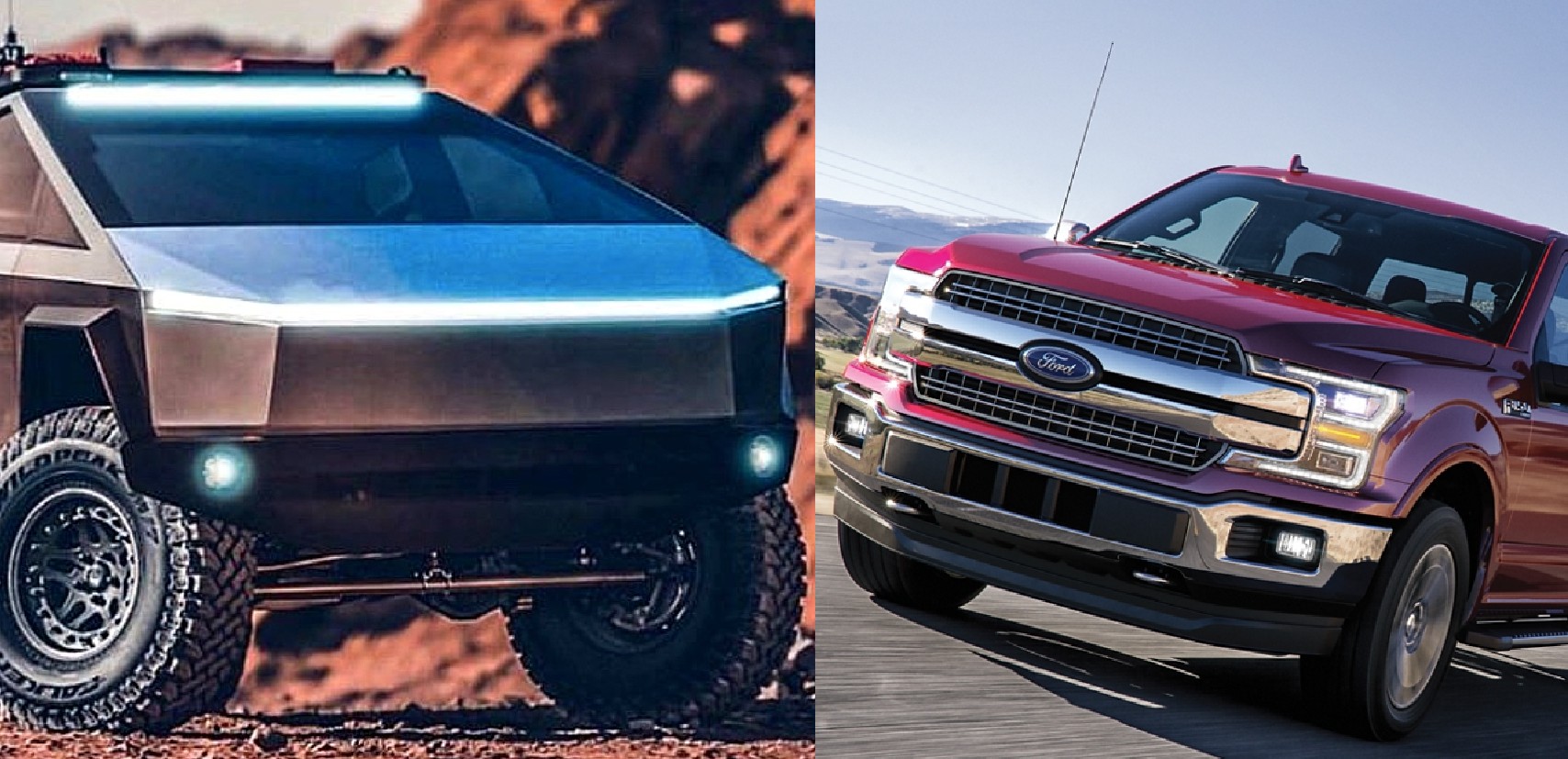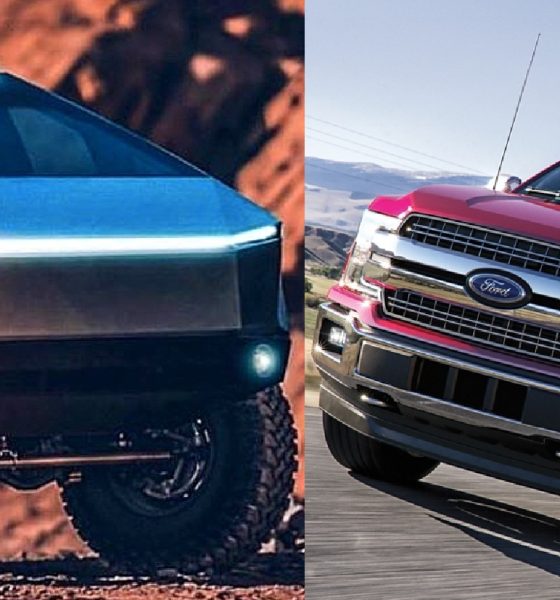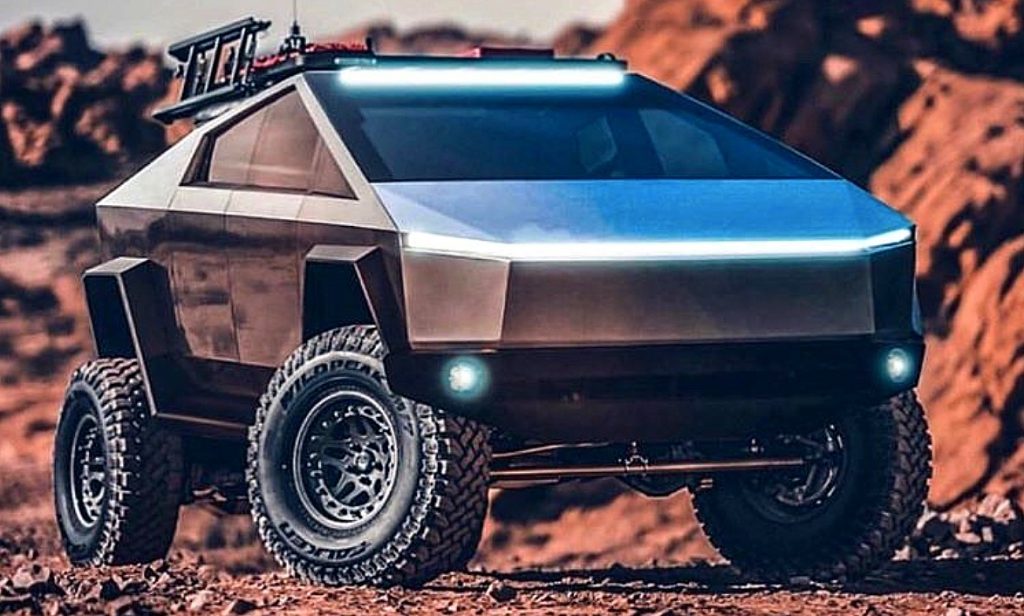

News
Tesla Cybertruck dodges competition from an electric Ford F-150 due to pandemic
There was a time when the Tesla Cybertruck seemed to be headed for a head-on collision with Ford’s electric F-150 when the vehicles enter the market. But if recent reports from Ford are any indication, it appears that the Cybertruck may end up losing one of its potential rivals when it begins production late next year.
With the electric pickup truck segment emerging, vehicles like the Tesla Cybertruck, Rivian R1T, Ford F-150 Electric, and the GMC Hummer EV appeared to be set for a rivalry. The market for electric pickups is immense, considering how popular trucks are in the United States. Few electric trucks have been unveiled by automakers so far as well, leaving the segment free for the taking.
While electric pickups like the Tesla Cybertruck and Rivian R1T were created by companies that are electric from their roots, other vehicles like the Ford F-150 electric and Hummer EV are the products of legacy automakers aiming to break into the electric sphere. Ford, for its part, has taken a significant stake in Rivian, and it has announced its intentions to utilize the EV truckmaker’s tech for its upcoming vehicles.

Among these is an all-electric SUV under Ford’s luxury brand, Lincoln. Following this, other electric pickups and SUVs were expected to be released, some of which will be using Rivian’s skateboard platform. Among these is the F-150 electric, a truck that was demonstrated to have enough power to pull a 1 million-pound freight train loaded with other F-150 pickups.
Unfortunately, Ford has announced to Automotive News that its Rivian-based Lincoln all-electric SUV has been officially canceled. Lincoln did state that it will still be working with Rivian and it will be releasing a vehicle based on the EV company’s skateboard platform, but it would be an “alternative vehicle,” not an EV.
“Given the current environment, Lincoln and Rivian have decided not to pursue the development of a fully electric vehicle based on Rivian’s skateboard platform. Our strategic commitment to Lincoln, Rivian and electrification remains unchanged and Lincoln’s future plans will include an all-electric vehicle,” a Lincoln spokesperson said.

Such a development may end up delaying the release of Ford’s all-electric vehicles, including the highly-anticipated F-150 EV. Ford has not disclosed if the all-electric pickup will be using Rivian’s tech or skateboard platform, but such a strategy would not be surprising considering the company’s $500 million investment in the young truck maker last year.
It is unfortunate, but the delay in the electric Ford F-150 may very well benefit the Tesla Cybertruck. Tesla’s expansion plans have remained relatively unchanged despite the ongoing pandemic, and save for the Semi; the electric car maker has not announced any other significant delays to its upcoming vehicles. The Roadster’s release may be adjusted as well, considering that its initial delivery estimate was set for this year, but that’s a low-volume supercar, with Elon Musk expecting to produce just around 10,000 per year.
The following year would definitely be critical for the industry’s electric truck makers. Due to the ongoing pandemic, delays in vehicle releases have been announced. Even Rivian, which beat Tesla to the punch in unveiling its electric truck, has announced that R1T and R1S deliveries have been moved to 2021. GM has also revealed that the Hummer EV’s unveiling has been delayed. With the Ford F-150 electric likely moved back, the electric pickup market next year may end up being dominated mainly by the Cybertruck and the R1T, at least depending on Rivian and Tesla’s capability to build and deliver their vehicles.

Elon Musk
Elon Musk and Tesla AI Director share insights after empty driver seat Robotaxi rides
The executives’ unoccupied tests hint at the rapid progress of Tesla’s unsupervised Robotaxi efforts.

Tesla CEO Elon Musk and AI Director Ashok Elluswamy celebrated Christmas Eve by sharing personal experiences with Robotaxi vehicles that had no safety monitor or occupant in the driver’s seat. Musk described the system’s “perfect driving” around Austin, while Elluswamy posted video from the back seat, calling it “an amazing experience.”
The executives’ unoccupied tests hint at the rapid progress of Tesla’s unsupervised Robotaxi efforts.
Elon and Ashok’s firsthand Robotaxi insights
Prior to Musk and the Tesla AI Director’s posts, sightings of unmanned Teslas navigating public roads were widely shared on social media. One such vehicle was spotted in Austin, Texas, which Elon Musk acknowleged by stating that “Testing is underway with no occupants in the car.”
Based on his Christmas Eve post, Musk seemed to have tested an unmanned Tesla himself. “A Tesla with no safety monitor in the car and me sitting in the passenger seat took me all around Austin on Sunday with perfect driving,” Musk wrote in his post.
Elluswamy responded with a 2-minute video showing himself in the rear of an unmanned Tesla. The video featured the vehicle’s empty front seats, as well as its smooth handling through real-world traffic. He captioned his video with the words, “It’s an amazing experience!”
Towards Unsupervised operations
During an xAI Hackathon earlier this month, Elon Musk mentioned that Tesla owed be removing Safety Monitors from its Robotaxis in Austin in just three weeks. “Unsupervised is pretty much solved at this point. So there will be Tesla Robotaxis operating in Austin with no one in them. Not even anyone in the passenger seat in about three weeks,” he said. Musk echoed similar estimates at the 2025 Annual Shareholder Meeting and the Q3 2025 earnings call.
Considering the insights that were posted Musk and Elluswamy, it does appear that Tesla is working hard towards operating its Robotaxis with no safety monitors. This is quite impressive considering that the service was launched just earlier this year.
Elon Musk
Starlink passes 9 million active customers just weeks after hitting 8 million
The milestone highlights the accelerating growth of Starlink, which has now been adding over 20,000 new users per day.

SpaceX’s Starlink satellite internet service has continued its rapid global expansion, surpassing 9 million active customers just weeks after crossing the 8 million mark.
The milestone highlights the accelerating growth of Starlink, which has now been adding over 20,000 new users per day.
9 million customers
In a post on X, SpaceX stated that Starlink now serves over 9 million active users across 155 countries, territories, and markets. The company reached 8 million customers in early November, meaning it added roughly 1 million subscribers in under seven weeks, or about 21,275 new users on average per day.
“Starlink is connecting more than 9M active customers with high-speed internet across 155 countries, territories, and many other markets,” Starlink wrote in a post on its official X account. SpaceX President Gwynne Shotwell also celebrated the milestone on X. “A huge thank you to all of our customers and congrats to the Starlink team for such an incredible product,” she wrote.
That growth rate reflects both rising demand for broadband in underserved regions and Starlink’s expanding satellite constellation, which now includes more than 9,000 low-Earth-orbit satellites designed to deliver high-speed, low-latency internet worldwide.
Starlink’s momentum
Starlink’s momentum has been building up. SpaceX reported 4.6 million Starlink customers in December 2024, followed by 7 million by August 2025, and 8 million customers in November. Independent data also suggests Starlink usage is rising sharply, with Cloudflare reporting that global web traffic from Starlink users more than doubled in 2025, as noted in an Insider report.
Starlink’s momentum is increasingly tied to SpaceX’s broader financial outlook. Elon Musk has said the satellite network is “by far” the company’s largest revenue driver, and reports suggest SpaceX may be positioning itself for an initial public offering as soon as next year, with valuations estimated as high as $1.5 trillion. Musk has also suggested in the past that Starlink could have its own IPO in the future.
News
NVIDIA Director of Robotics: Tesla FSD v14 is the first AI to pass the “Physical Turing Test”
After testing FSD v14, Fan stated that his experience with FSD felt magical at first, but it soon started to feel like a routine.

NVIDIA Director of Robotics Jim Fan has praised Tesla’s Full Self-Driving (Supervised) v14 as the first AI to pass what he described as a “Physical Turing Test.”
After testing FSD v14, Fan stated that his experience with FSD felt magical at first, but it soon started to feel like a routine. And just like smartphones today, removing it now would “actively hurt.”
Jim Fan’s hands-on FSD v14 impressions
Fan, a leading researcher in embodied AI who is currently solving Physical AI at NVIDIA and spearheading the company’s Project GR00T initiative, noted that he actually was late to the Tesla game. He was, however, one of the first to try out FSD v14.
“I was very late to own a Tesla but among the earliest to try out FSD v14. It’s perhaps the first time I experience an AI that passes the Physical Turing Test: after a long day at work, you press a button, lay back, and couldn’t tell if a neural net or a human drove you home,” Fan wrote in a post on X.
Fan added: “Despite knowing exactly how robot learning works, I still find it magical watching the steering wheel turn by itself. First it feels surreal, next it becomes routine. Then, like the smartphone, taking it away actively hurts. This is how humanity gets rewired and glued to god-like technologies.”
The Physical Turing Test
The original Turing Test was conceived by Alan Turing in 1950, and it was aimed at determining if a machine could exhibit behavior that is equivalent to or indistinguishable from a human. By focusing on text-based conversations, the original Turing Test set a high bar for natural language processing and machine learning.
This test has been passed by today’s large language models. However, the capability to converse in a humanlike manner is a completely different challenge from performing real-world problem-solving or physical interactions. Thus, Fan introduced the Physical Turing Test, which challenges AI systems to demonstrate intelligence through physical actions.
Based on Fan’s comments, Tesla has demonstrated these intelligent physical actions with FSD v14. Elon Musk agreed with the NVIDIA executive, stating in a post on X that with FSD v14, “you can sense the sentience maturing.” Musk also praised Tesla AI, calling it the best “real-world AI” today.








